Yesterday |
||||||||||||||||||||||
|
|
||||||||||||||||||||||
Crochet DROPS jumper with lace pattern, round yoke and detachable collar, worked top down in ”Merino Extra Fine”. Size: S - XXXL.
DROPS 156-18 |
||||||||||||||||||||||
|
PATTERN: See diagrams A.1-A.4. CROCHET INFO: Replace first dc on every round with 3 ch. Finish every dc round with 1 sl st in 3rd ch from beg of round. Replace first sc on every round with 1 ch. Finish every sc round with 1 sl st in 1st ch on round. INCREASE TIP: Inc 1 st by working 2 dc in 1 dc, first on one side of all markers on round, next time on the other side of all markers on round, continue inc like this. DECREASE TIP: Work 1 dc but wait with last pull through (= 2 sts on hook), then work next dc but on last pull through, pull yarn through all sts on hook = 1 dc dec. ---------------------------------------------------------- BODY: The piece is worked top down. Worked in the round from mid back. Work 93-98-103-113-118-128 ch on hook size 4.5 mm/US 7 with Merino Extra Fine and form a ring with 1 sl st in first ch. Work next round as follows: ch 1, 1 sc in first ch, 1 sc in each of the next ch 2, * skip ch 1, 1 sc in each of the next 4 ch *, repeat from *-* = 76-80-84-92-96-104 sc – READ CROCHET INFO. Then work an elevation in the back of neck as follows: ROUND 1 (= RS): Beg mid back, work ch 1, 1 sc in 1st sc, * ch 1, skip 1 sc, 1 sc in next sc *, repeat from *-* around the neck AT THE SAME TIME insert 1 marker after 38-40-42-46-48-52 sts (= mid front), turn piece. ROW 2 (= WS): Work 1 sc in every ch and 1 ch over every sc around the neck until 28-30-32-36-38-42 sts remain until marker, turn piece. ROW 3: Work 1 sc in every ch and 1 ch over every sc until 28-30-32-36-38-42 sts remain until marker, turn piece. ROW 4: Work 1 sc in every ch and 1 ch over every sc around the neck until 22-24-26-30-32-36 sts remain until marker, turn piece. ROW 5: Work 1 sc in every ch and 1 ch over every sc around the neck until 22-24-26-30-32-36 sts remain until marker, turn piece. ROW 6: Work 1 sc in every ch and 1 ch over every sc around the neck until 16-18-20-24-26-30 sts remain until marker, turn piece. ROW 7: Work 1 sc in every ch and 1 ch over every sc until 16-18-20-24-26-30 sts remain until marker, turn and work back to mid back. Then work in the round with dc AT THE SAME TIME on 1st round insert 19-20-21-23-24-26 markers in piece as follows: Insert 1st marker at beg of round (= mid back), then insert 18-19-20-22-23-25 markers 4 dc apart, after last marker there are 4 dc. Work in the round with dc AT THE SAME TIME inc 1 dc at all markers as follows: Inc every other round 5-6-6-5-5-6 times, and every 4th round 2-2-2-3-3-3 times - READ INCREASE TIP = 209-240-252-276-288-338 dc. Work a round while at the same time inc 14-7-7-7-19-5 dc evenly = 223-247-259-283-307-343 dc. REMEMBER THE CROCHET GAUGE! On next round work as follows from mid back: 30-34-37-41-45-52 dc, 8 ch (under sleeve), skip 52-56-56-60-64-68 dc from previous round (to be used for sleeve later), 60-68-74-82-90-104 dc (front piece), 8 ch (under sleeve), skip 52-56-56-60-64-68 dc from previous round (to be used for sleeve later) and 29-33-36-40-44-51 dc = 135-151-163-179-195-223 dc/ch. Insert a marker, now measure piece from here! Work 1 dc in every dc/ch AT THE SAME TIME dec 8-8-8-12-12-12 sts evenly – READ DECREASE TIP = 127-143-155-167-183-211 dc. Continue to work as follows: Work A.1, A.2 30-34-37-40-44-51 repetitions in total in width, finish with A.3. Continue pattern like this. When A.1-A.3 have been worked 1 time vertically, repeat A.4 vertically until finished measurements. When piece measures 14-14-14-15-15-15 cm / 5½"-5½"-5½"-6"-6"-6" from marker, adjust so that next round is last round in A.4, inc 1 repetition of A.2 in 8th-9th-9th-10th-11th-13th repetition in ch-space as follows: Work ch 2, 1 sc in ch-space, ch 2, 1 dc in same ch-space, ch 2, 1 sc in same ch-space. Work 14-16-19-20-22-25 repetitions of A.2, in next repetition of A.2 inc the same way. Then continue as before = 32-36-39-42-46-53 repetitions of A.2 in width. Fasten off when piece measures 34-34-36-35-37-37 cm / 13½"-13½"-14¼"-13¾"-14½"-14½" from marker, adjust to finish with next to last round in A.4, piece measures 56-58-60-62-64-66 cm / 22"-22¾"-23⅝"-24⅜"-25¼"-26" in total. SLEEVE: Sleeve is worked in the round, top down. Insert a marker, now measure piece from here! Beg by working mid under sleeve as follows: Work 1 sc in 5th ch of the 8 ch work in armhole on body, 3 ch (= 1 dc), work 1 dc in each of the next ch 3, 1 dc in every dc over sleeve, then work 1 dc in each of the remaining 4 ch under sleeve = 60-64-64-68-72-76 dc. Insert 1 marker mid under sleeve. Continue to work as follows: 1 dc in each of the first 11-11-11-13-13-15 dc AT THE SAME TIME dec 1 dc (= 10-10-10-12-12-14 dc), A.1, A.2 8-9-9-9-10-10 times in width, A.3, work 1 dc in each of the last 10-10-10-12-12-14 dc. Continue with 1 dc in each of the 20-20-20-24-24-28 dc mid under sleeve and A.1-A.3 over sleeve. When A.1-A.3 have been worked 1 time vertically, repeat A.4 vertically until finished measurements. Continue this pattern AT THE SAME TIME when piece measures 4 cm / 1½", dec 1 dc on each side of marker - Remember DECREASE TIP. Repeat dec every 3½-3½-3½-2½-2½-2 cm / 1¼"-1¼"-1¼"-⅞"-⅞"-¾" 9-9-9-11-11-13 more times. Now work only A.1-A.3 over sleeve. Fasten off when sleeve measures 43½-42½-42½-39½-40-38 cm / 17"-16¾"-16¾"-15½"-15¾"-15", adjust to finish with next to last round in A.4 – NOTE – shorter measurements in the larger sizes because of wider neck and shoulders. Work the other the same way. DETACHABLE COLLAR: Worked in the round. Work 99 ch on hook size 4.5 mm/US 7 with Merino Extra Fine and form a ring with 1 sl st in 1st ch. Work 3rd row in A.1, 3rd row in A.2 23 times and 3rd row in A.3. Repeat A.4 vertically until finished measurements. When piece measures 8 cm / 3⅛", adjust so that next round is last round in A.4, inc 1 repetition of A.2 in each side of piece as follows: Work A.1, then work first A.2 as follows: Work ch 2, 1 sc in ch-space, ch 2, 1 dc in same ch-space, ch 2, 1 sc in same ch-space. Work as before until 1 repetition of A.2 remains before A.3, in next repetition of A.2 inc the same way. Then work as before (= 25 repetitions of A.2 in width) until piece measures approx. 20 cm / 8", adjust to finish with next to last row in A.4. Fasten off. |
||||||||||||||||||||||
Diagram explanations |
||||||||||||||||||||||
|
||||||||||||||||||||||
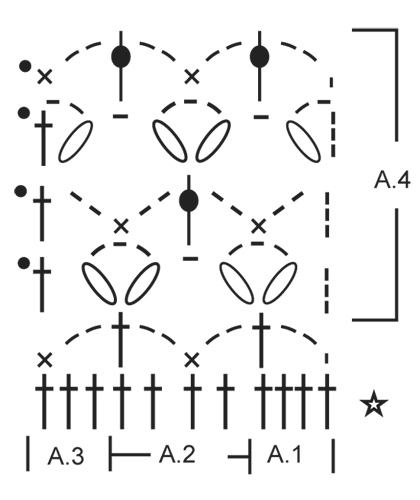
|
||||||||||||||||||||||

|
||||||||||||||||||||||
|
Have you made this or any other of our designs? Tag your pictures in social media with #dropsdesign so we can see them! Do you need help with this pattern?You'll find tutorial videos, a Comments/Questions area and more by visiting the pattern on garnstudio.com. © 1982-2024 DROPS Design A/S. We reserve all rights. This document, including all its sub-sections, has copyrights. Read more about what you can do with our patterns at the bottom of each pattern on our site. |
||||||||||||||||||||||








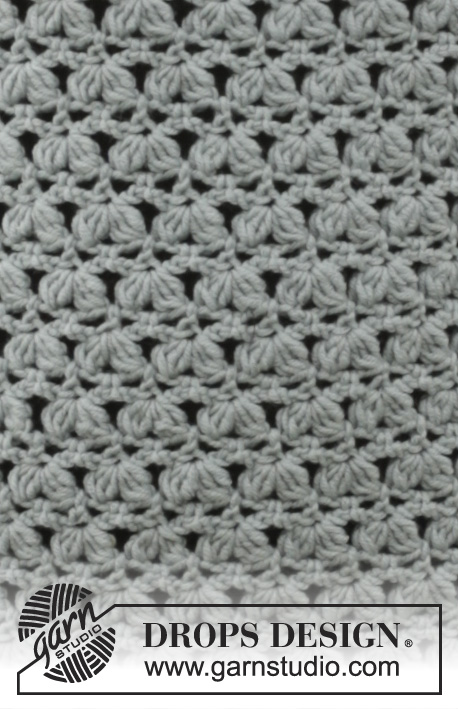













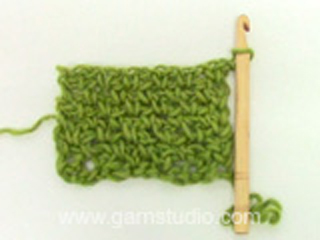

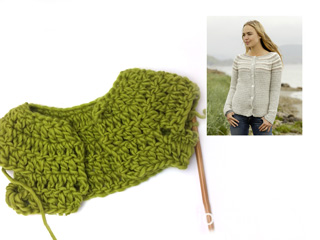





















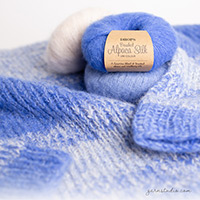




Comments / Questions (68)
Lyn wrote:
Oops, didn't mean to repost same question! Yes I have checked and double checked the number of rounds and my tension is pretty spot on, maybe slightly tighter but not enough to make that much difference. I am making medium size
23.06.2015 - 23:34Lyn wrote:
I am crocheting Pattern 156-18 but it's not looking like the picture. I have completed the treble bodice and into the lace pattern. Even though my measurements seem to be correct for pattern size my bodice appears much shorter than the in the picture where it comes well below the bust line closer to waist. Mine sits high across my bust. Can you offer any explanation? If I lengthen the treble bodice will it mess up the sleeves?
23.06.2015 - 15:26DROPS Design answered:
Dear Lyn, do you also get the corret tension in height, ie 9 rows tr = 10 cm ? You can also check that you have the correct number of rounds for yoke. Happy crocheting!
23.06.2015 - 19:29It is still very confusion. Please can you just confirm how many sts I should work for ROW 2, and how many sts I should work for ROW if for 2nd size? Thx Jing
19.06.2015 - 14:25DROPS Design answered:
Dear Mrs Wang, as you said, on row 2 in 2nd size, you work 10 sts (= leave 30 sts unworked before marker mid front), turn and work these 10 sts back (to marker mid back) + 10 sts past marker mid back (= 30 sts are unworked before marker mid front). Count the sts you leave unworked before starting your next row will help you to make the short rows. Happy crocheting!
19.06.2015 - 18:22Just for your information, I started Body pattern with ch 98. So I inserted 1 marker after 40 sts(mid front) for ROUND 1.
19.06.2015 - 01:44DROPS Design answered:
Dear Mrs Wang, then in 2nd size, work row 2 from WS until 30 sts remain before marker mid front, turn and work row 3 froms RS until 30 sts remain before marker mid front on the other side, turn and work row 4 from WS until 24 sts remain before marker mid front, turn and work row 5 from RS until 24 sts remain before marker mid front on the other side .. Happy crocheting!
19.06.2015 - 09:59Thank you for your answers. If I "work row 2 from WS until 28-42 sts remain before marker mid front, do not work these sts (leave them unworked), turn", does that mean I will only work 10sts for Row 2, after turning, I will only work 20sts for Row 3 ? thx
19.06.2015 - 01:40DROPS Design answered:
Dear Mrs Wang, that's correct for row 2 and 3, then you continue leaving less sts unworked each side as stated for your size. Happy crocheting!
19.06.2015 - 09:50Ok, question 1 is clear now with thx. But I am still confused on question 2. If I "work row 2 from WS until 28-42 sts (see size) remain before marker on mid front, ... Do you mean Not to work all the way cross the maker, but before the maker 28-42 sts? Jing
15.06.2015 - 21:07DROPS Design answered:
Dear Mrs Wang, that's right you will work row 2 from WS until 28-42 sts remain before marker mid front, do not work these sts (leave them unworked), turn, work next row from RS until 28-42 sts remain on the other side of mid front, do not work these sts, turn and work next row, leaving more sts unworked before marker mid front and so on = you will work more rows over some sts this will create an elevation on mid back. Happy crocheting!
16.06.2015 - 08:33Jing Wang wrote:
I have got a few questions for Body pattern: 1. With regard to Round 1, I understand it that I need to work all the way round, not half way, but insert a maker after 38-40-42-46-48-52; Is it right? 2. at Row 2, if I work it as it says and until 28-30-32-36-38-42sts remain until maker, (then turn pieie for Row 3) how can I still do the same (I mean work the same until 28-30-32-36-38-42sts remain until maker) at Row 3 ? ? ? Jing
14.06.2015 - 19:25DROPS Design answered:
Dear Mrs Wang, 1. is correct, then 2. on row 2 you start working short rows for the elevation in the back of the neck: work row 2 from WS until 28-42 sts (see size) remain before marker on mid front, turn and work row 3 from RS until 28-42 sts remain before marker on mid front on the other side. Repeat these 2 rows leaving some more sts unworked at the end of each row on both sides of marker mid front. Happy crocheting!
15.06.2015 - 10:37Beste, dank u voor de gekregen uitleg. Maar ik heb nog een vraagje. Ik was ondertussen al willen beginnen aan die kraag van patroon 156-18. Het is toch een losse hangende kraag, maar ik weet niet hoe ik die meerderen moet uitvoeren. Wil je mij eens duidelijk uitleggen hoe ik dit moet doen aub. Dank u en groetjes. Carine
12.02.2015 - 08:58DROPS Design answered:
Hoi Carine. Je moet haken zoals staat in het patroon: haak A.1, haak dan de eerste A.2 als volgt: haak 2 l, 1 v in de l-lus, 2 l, 1 stk in dezelfde l-lus, 2 l, 1 v in dezelfde l-lus. (dit is de meerdering). aak als hiervoor tot er 1 herhaling van A.2 overblijft voor A.3 en meerder in de volgende herhaling van A.2 op dezelfde manier. Dwz, herhaal hier "2 l, 1 v in de l-lus, 2 l, 1 stk in dezelfde l-lus, 2 l, 1 v in dezelfde l-lus"
12.02.2015 - 17:16Ik versta 'het haken van een ronding op het achterpand van de hals niet. Vanaf toer 1 tot en met toer 7 versta ik niet. ik wil dolgraag deze pull haken, maar hoe begin ik eraan ? Dank U groetjes
11.02.2015 - 08:42DROPS Design answered:
Hoi Carine. In toer 1 heb je 1 markeerder na 38-40-42-46-48-52 st geplaatst (afhankelijk van je gekozen maat). De markeerder = middenvoor, begin van de toer = middenachter. Je haakt nu heen en weer. Dus toer 2 haak je v/l tot 28-30-32-36-38-42 st voor de markeerder. Keer het werk en haak terug tot 28-30-32-36-38-42 st voor de markeerder aan de andere kant, keer enzovoort. Op deze manier haak je een verhoging op de achterkant.
11.02.2015 - 15:53Hi, I have some questions about the sleeves of this pattern. It seems that after the first round I have to dc 13, then decrease one and then start on the detail on the sleeve? But in the pictures the sleeves don't start with the detail until halfway. The sleeve pattern is very confusing..
06.02.2015 - 18:06DROPS Design answered:
Dear Mary, the jumper is worked top down, ie you first work yoke in the round, leave sts unworked on each side for sleeves and continue body in the round. Sleeves are then worked top down over the skipped sts on yoke. Happy crocheting!
07.02.2015 - 09:53